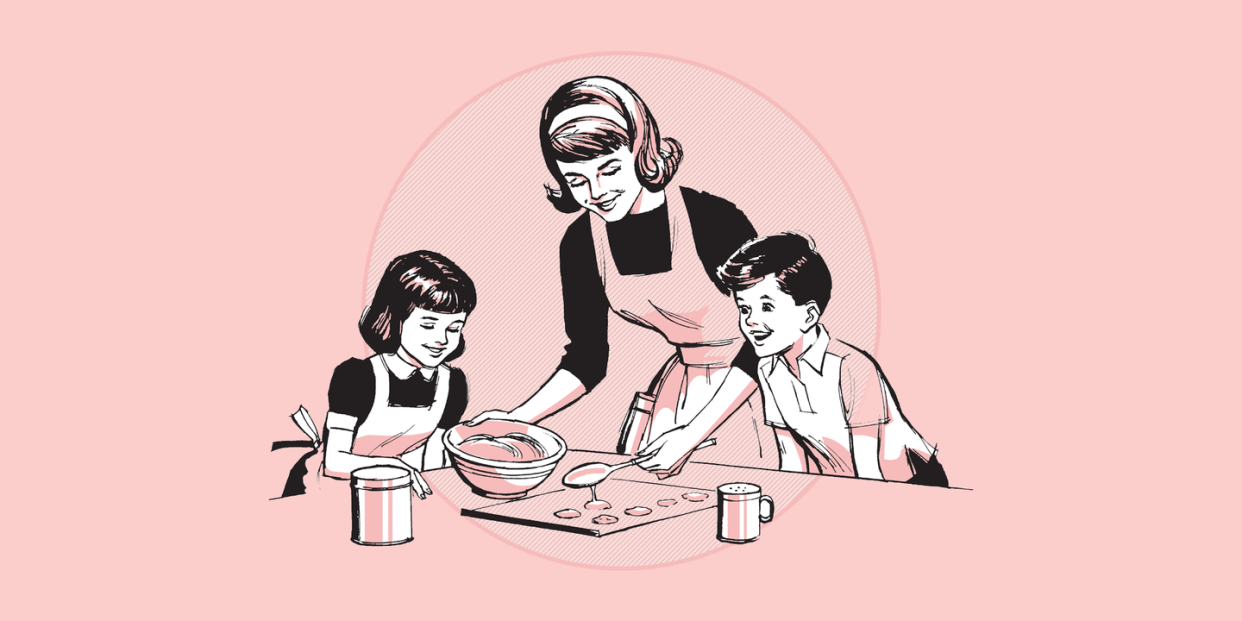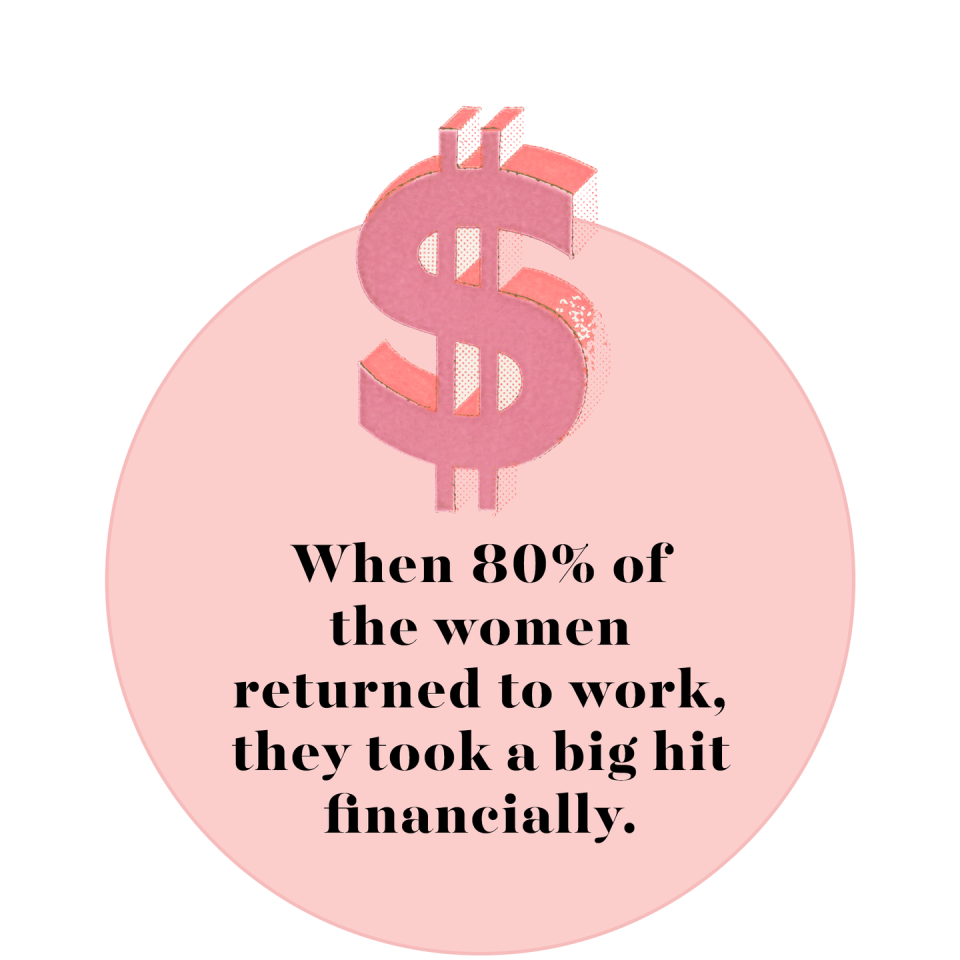Why Is Re-Entering the Workforce So Hard on Moms?

In April 2020, at the height of the COVID-19 pandemic, Nicole Peyer, 44, of Oakland, CA, was furloughed from her job as a sales consultant for a national wine and spirits distribution company.
After four months, Peyer was rehired, but her needs had changed: With two elementary-school aged kids remote learning at home, she requested a more flexible schedule that would allow her to trade off on childcare with her husband — but her employers wouldn’t budge. “I think they wanted to hear that I cared about my job more than my kids,” she said. “My work, being out in the field and visiting clients, was not conducive to the fact that I now had children to watch at home because daycare and school were closed.”
Two months later, unable to keep up with full-time work on top of childcare, Peyer resigned. Now, she’s struggling to find a sense of purpose beyond cooking and cleaning. "All of a sudden, I’m not waking up and checking my phone first thing. My busy-ness now is commuting the kids around," she says. "I’m still in touch with my old teammates, and I feel guilty that they’re going to work and I’m not."
Prior to the pandemic, women spent significantly more time on housework and childcare than men, even when both spouses worked full-time, according to the Institute for Women’s Policy Research. And when schools and daycares shut down as a result of COVID-19, working moms like Peyer picked up even more responsibilities. But even in the best of times, many moms are left with no choice but to step away from their jobs to raise their kids, sacrificing their careers until their children are old enough to start school.
And when stay-at-home mothers do decide they're ready to rejoin the workforce, they're often faced with workplaces that don't fit their new life circumstances and employers who don't understand their needs. But for moms who are trying to figure out how to get back into the workforce, there are a few things they (and employers) can do to make the transition work.
The pandemic drove many moms out of the workforce
The sectors that disproportionately hire women, which are typically “plentiful and relatively protected,” were the ones hit hardest by the pandemic, according to Claudia Goldin, Henry Lee Professor of Economics at Harvard University. Those include the service, hospitality and retail industries. Using Current Population Survey Annual Social and Economic Supplement microdata, Goldwin calculated the change in labor force participation rates the year before the pandemic vs. the year of the pandemic and found that four groups experienced the largest change:
Non-college educated women ages 25-34 whose youngest child was between 0-4 saw a 5.9% decrease in labor force participation.
Non-college educated women ages 25-34 whose youngest child was 5-13 saw a 4.7% decrease.
College educated women ages 35-44 whose youngest child was 5-13 saw a 4.9% decrease.
College educated women ages 35-44 whose youngest child was 0-4 saw a 3.1%. decrease.
“The bottom line here is that women have taken a big hit,” Goldin says. Among college educated women, those with school-aged kids were more affected than those with younger kids. That might be because daycare facilities remained open in many areas, even when schools pivoted to virtual learning, she explains.
Courtney Motz, 39, experienced this impact firsthand. In March 2020, she was laid off from her job as an events planner at the Wilmington, NC restaurant where she’d worked for over four years. At first, she sent out a few resumes, but with schools closed and a 7-year-old to care for at home, she decided to wait things out. “I wasn’t willing to pay for childcare just to go back to work,” Motz says.
A year in, she insists she’ll never again work in the service industry, where balancing career with family felt impossible. "I couldn’t take a personal day unless I had a doctor’s note," she says. "I’d literally close the restaurant at midnight and turn around to be back at 8 a.m."
Moms who "lean out" often lose their sense of self
Those challenges moms face at work are by design. The workplace was originally designed to fit the realities of men’s lives, says Hilary Berger, Ed.D., LPC, career counselor and founder of Work Like a Mother, and concerns about daily childcare responsibilities are still not always factored into the equation. “[Many employers] don’t honor or validate the multiple roles that women take on in life. A woman’s professional role is not disposable,” she says. “It's part of their identity.” That’s why it’s so difficult for women when they step away from their careers — their confidence is often lost, along with their professional identity.
“Being a mother is a wonderful role in life, but it’s completely ‘other’ focused; you’re focused on your children’s and your partner’s well-being,” she explains. “Very subtly, mothers become needless, and in many ways, invisible. They almost disappear in plain sight.”
Motz has experienced that phenomenon firsthand. “I definitely struggle with some depression since not working,” she says. Often, I feel like I’ve lost my purpose and value, so it’s been difficult to adjust my mindset to what my new purpose is supposed to be, and deal with the fact that it is solely in the house.” She also worries what she’ll do if returning to work becomes financially necessary, knowing that she’ll likely need to go back to school in order to switch careers.
While it’s impossible to predict exactly what the post-pandemic job market will look like, Pamela Stone, Professor of Sociology at Hunter College and the Graduate Center, CUNY and co-author of Opting Back In, What Really Happens When Mothers Go Back to Work, is optimistic that women who choose to will be able to go back to work. “Employment prospects are functions of supply and demand,” she explains. “There’s every reason to believe that when we're back to business, jobs will return.”
But even if there are jobs to go back to, we have a long way to go in leveling the playing field for working moms both at home and on the job. “If this pandemic occurred and men needed to leave their professions to go home to educate their children, workplace and government policies would have kicked into gear to create more reasonable and survivable strategies so that men did not have to lose their jobs,” Berger muses. Women like Motz will face an uphill battle, especially after some time away.
Working women with kids often have to compromise
I have to admit that my interest in this topic is personal. After spending six years as a stay-at-home mom to raise my son, I decided (pre-pandemic) to re-enter the workforce. Though I’m a college graduate with over a decade of experience in corporate accounting, several months into submitting nearly 30 applications for jobs I easily qualified for, I’d landed zero interviews. I began to wonder if my hiatus from full-time employment had made my prior work history irrelevant in the eyes of prospective employers. Even when I began applying to jobs below my skill set, my prospects remained bleak. When I found myself, defeated, completing a basic computer skills assessment at a temp agency, I realized finding a job wasn’t going to be the cakewalk I’d imagined.
I’m certainly not alone. Rather than aspiring to be full-time moms, many professional women get pushed out of their fields because they received no support from their employers, Stone says. She studied a group of 43 college-educated women who worked 10 years on average before quitting to stay home with their children.

Ultimately, when about 80% of the women returned to work, they took a big hit financially. Only half of them were able to return to secure, full-time jobs with benefits. “At first, they accepted work that was well below their skill level and qualifications, or project-based work,” says Stone. “For example, an executive at a healthcare firm was asked to be a receptionist at a friend’s medical practice.”
Some moms have to forge new career paths
When re-entering the workforce, many of the former stay-at-home moms in Stone's study had to reinvent themselves in order to accommodate their new schedules and family-focused priorities. “Women who stayed in the same field went back on a freelance basis, so they had the flexibility they needed as moms, but they had to sacrifice on pay,” she explains. Often, trial-and-error and volunteering opportunities exposed them to alternative career paths in female-dominated fields they wouldn’t have considered prior to starting a family, such as education and the nonprofit sector. And while the majority of the women were very happy in their second careers, “the onus really fell on them to reset themselves,” Stone explains. “The workplace hasn’t transformed itself to being family friendly. They’ve had to change in order to find a place in it.”
In August 2020, after six months of job-hunting, I accepted a part-time, low-stress job doing bookkeeping and general office work for a child psychologist. The position was a great opportunity to update my existing skills and learn new ones, including several online platforms that were previously unfamiliar to me.
After a year, I relocated to another state, and working remotely was too much to manage on top of guiding my second grader’s remote learning. Having dipped my toes back into the workforce and after several years of contributing to local parenting publications, I decided to put all of my free time into freelance writing. Signing up for writing classes and conferences to build my network and focusing on establishing relationships with new publications, I began to regain a sense of purpose and worth unrelated to being a mother.
Redefining what a "career" means before starting again
When it comes to stay-at-home moms re-entering the workforce, Berger says there are no shortcuts. Like any prospective employee, women need a current and relevant skill set that makes them competitive. Instead of giving in to the fear of not being good enough, Berger urges taking active steps to build up your confidence and make your application more attractive to employers, integrating professionally relevant activities into your day-to-day life.
Learn new digital tools, take a virtual class, or build an online presence by creating a blog or a personal website, Berger suggests. Assess what it is that gives you purpose now, which often shifts with time and new life stages. Explore online job postings and find an ideal position you can imagine yourself in, then look at the required skills and qualifications to begin to build your foundation, she suggests.
Women re-entering the workforce need more support
Even as moms prepare themselves to re-enter the workforce, it's not all on the individual. Government policies and employers need to support working parents by creating a family-centric workplace that adjusts to the realities of women's home and work lives, incorporating supports like equal pay, flex-time, paid family leave, employment-protected long-term leave, and childcare referral programs, says Berger. “With so much focus on diversity and inclusion in our society, women who are parents represent a huge segment of our population that has experienced bias as work,” she explains.
At home, working moms need to set boundaries so they have time to tend to their own needs, with kids and partners stepping up to share in the workload, Berger advises.“The notion that somehow women can do their job while educating their children and shopping, cooking, and doing laundry, plus keeping their kids’ needs met is outrageous.”
Women can provide a support system for each other too, Peyer adds. As women, we should be supporting each other and talking about our challenges honestly. “Once you start doing that,” she explains, “you stop feeling like a failure.”
You Might Also Like

